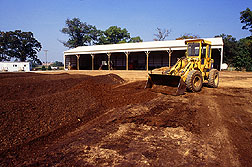This page has been archived and is being provided for reference purposes only. The page is no longer being updated, and therefore, links on the page may be invalid.
|
|
USDA Opens New Compost FacilityBy Don ComisOctober 20, 1997 BELTSVILLE, Md., Oct. 20--The U.S. Department of Agriculture's new compost research facility here will demonstrate the benefits of recycling--saving the environment and money--Deputy Agriculture Secretary Richard Rominger said today at a 10:00 a.m. dedication ceremony. "The scientists will develop and test new technologies for cooperative recycling-- ways to reduce urban landfill problems while turning excess nutrients and other potential pollutants into valuable products such as organic fertilizer for farms and gardens," said Rominger. "To put the research results into the hands of those who can use it, USDA will join with private industry to develop and transfer new recycling and composting technologies." The new facility is located at the Beltsville Agricultural Research Center (BARC), which is part of the Agricultural Research Service, USDA's chief scientific agency. "Composting converts nitrogen and other nutrients into stable forms that are less likely to enter waterways," said Rominger. "The facility will also help us comply with Maryland's voluntary nutrient management program, designed to keep nitrogen and phosphorus out of the Chesapeake Bay. The project also has national implications for developing similar recycling cooperation between farms and towns." The new facility's 77,000-square-foot composting pad is itself built partly of recycled materials such as coal ash from electric power plants. "We expect to save $13,000 a year by reducing landfill fees and by converting leftover farm, urban and industrial materials to fertilizer, potting mixes and mulch for use throughout the Beltsville center," Rominger said. To build the recycling pad, coal ash was mixed into the clay subsoil along with quick lime and cement dust, said Lawrence J. Sikora, an ARS microbiologist at Beltsville's Soil Microbial Systems Laboratory. The finished product is almost as durable as concrete or asphalt, but costs about one-fourth as much and is easier to repair, he added. Sikora said he believes this is the first composting pad built this way, although the basic technique has been successful on roads and dairy barn feedlot pads. The organic leftovers or residues are composted in nearly 20 "windrows" on the pad. "Each row is 160 feet long, 40 inches high and 5 feet wide, with about 45 tons of residue piled in a triangular shape," Sikora said. "We expect to compost about 10,000 tons a year." Since January, Randy Townsend, a Maryland-certified compost operator, has composted residue from BARC's farmland and greenhouses. The residues include cattle and poultry manure, used potting soil, dead greenhouse plants, landscape trimmings, unusable produce, hay, grains and corn ground as silage for cattle feed. For four years, Sikora and other ARS researchers have grown corn, soybeans and winter wheat in soils amended with residues from diverse sources, including cement and coal processors, seafood plants and compost producers. Yields were higher with many of the composts than with commercial fertilizer. Sikora and colleagues will use research bins to find ways to stabilize phosphorus, further reduce losses of nitrogen to the air and control odors. "We are also creating designer composts for specific uses such as natural biological biocontrol of vegetable diseases," Sikora said. Other residues for composting will include drywall and other construction scraps and byproducts from the electric power industry. On these projects, BARC is working with cooperators such as the Gypsum Association of Washington, D.C., and the National Association of Home Builders research center in Upper Marlboro, Md. Composting research at other ARS locations--including labs in Alabama, Pennsylvania, West Virginia and Texas--has led to two cooperative research and development agreements:
Scientific contact: Lawrence J. Sikora, microbiologist, Agricultural Research Service, Beltsville, Md., phone (301) 504-9384, fax (301) 504-8370, lsikora@asrr.arsusda.gov. |

